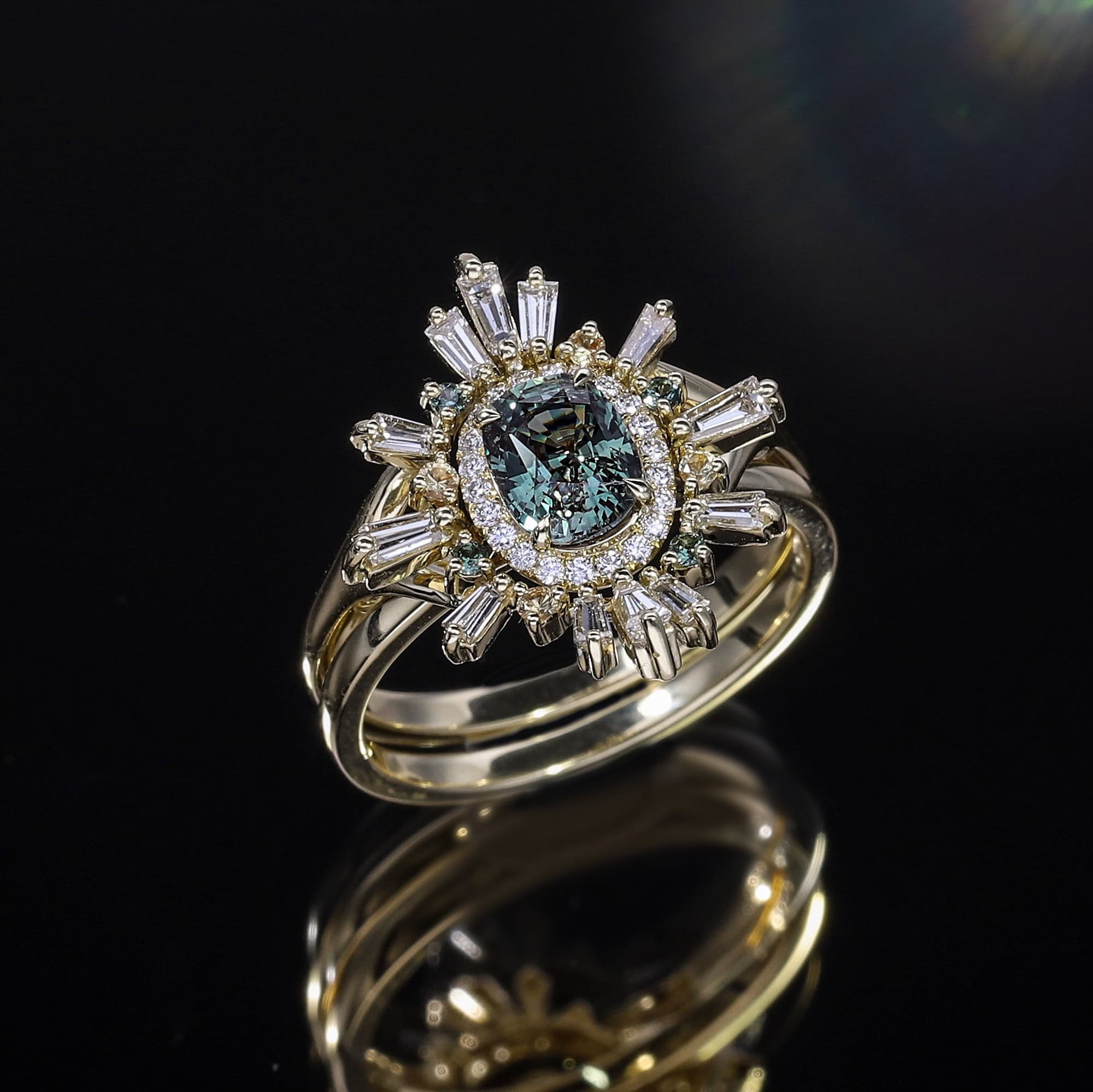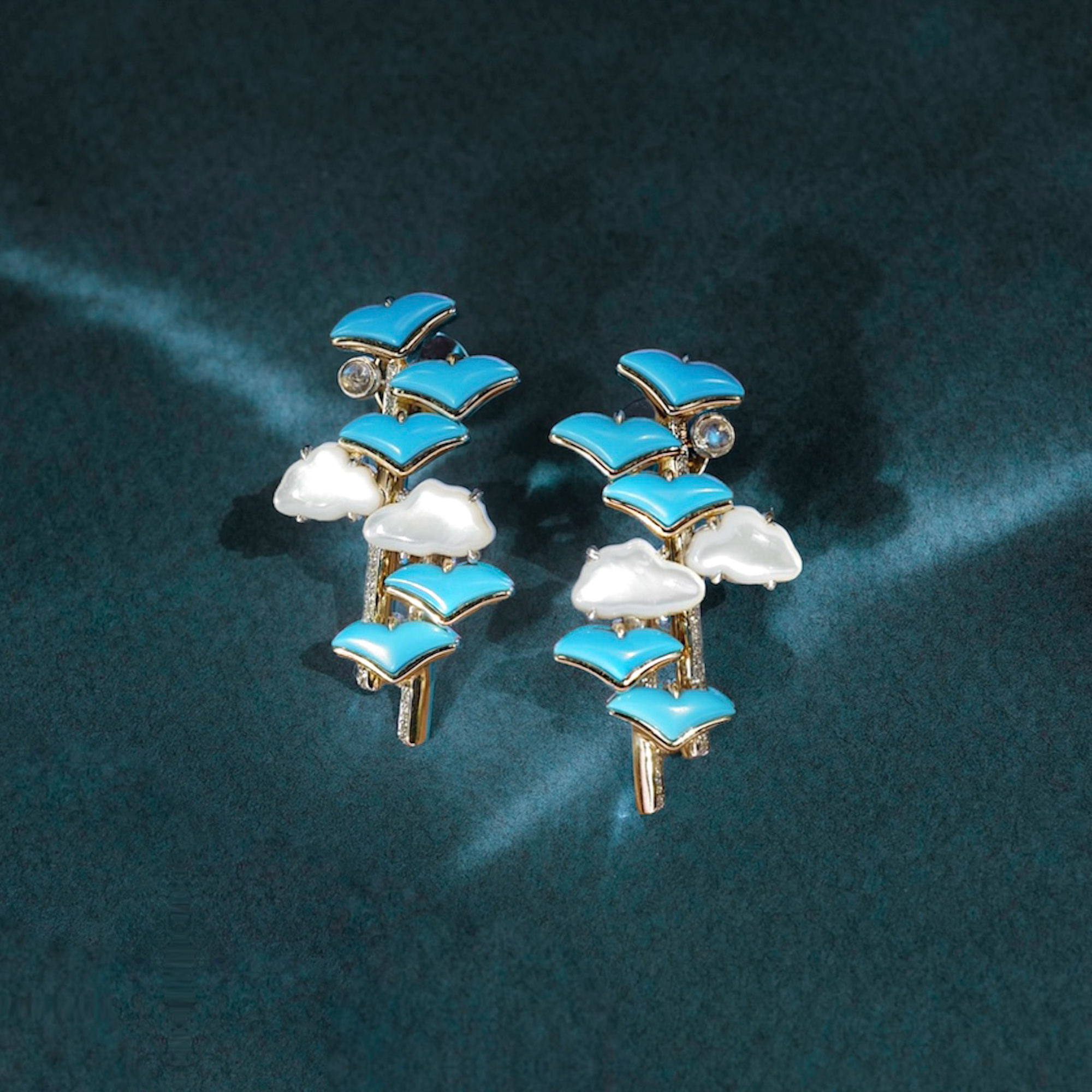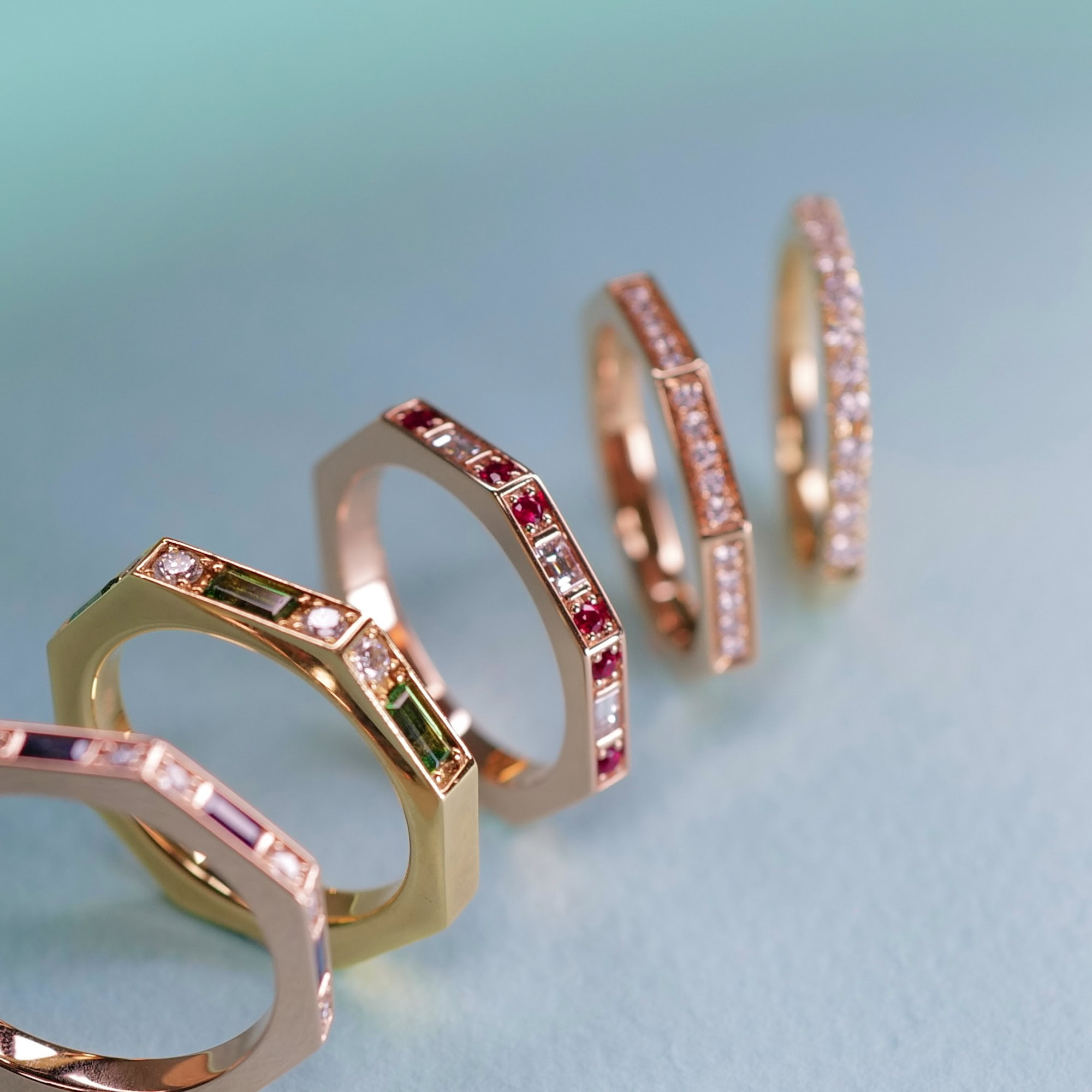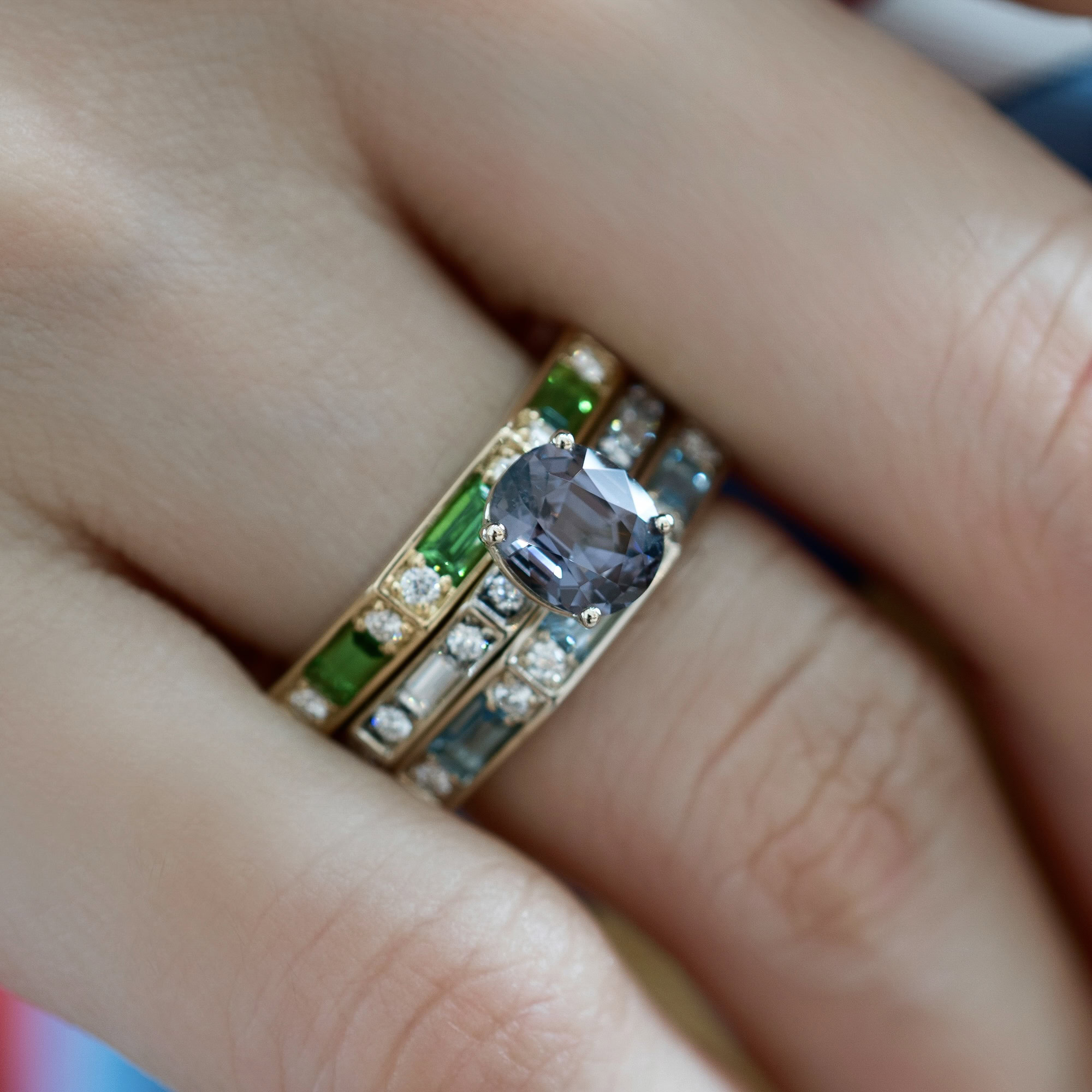The allure of Alexandrite is truly exceptional. As one of the rarest and most coveted gemstones, it captivates with its magnificent colour play and unique properties. If you’re not yet familiar with Alexandrite, it’s time to explore its enigma. Our comprehensive guide delves into the heart of this mysterious stone, revealing the secrets behind its mesmerising charm and why it’s a treasure in the world of precious gems. Discover the intriguing world of Alexandrite, a gem that stands out in the realm of fine jewellery.
What is Alexandrite?
Alexandrite is a rare and unique gemstone from the Chrysoberyl mineral family, known for its hardness and durability. It exhibits a distinct crystal formation called “trillings,” forming hexagons with mirror structures at 120 degrees. While there are other minerals in the Chrysoberyl family, Alexandrite is the rarest due to trace elements like iron, titanium, and particularly chromium in its composition. This rare combination of elements gives Alexandrite its distinctive characteristics, making it a highly sought-after gemstone.

Discovering the Unique Traits of Alexandrite: A Gemstone Beyond Compare
The enchanting allure of Alexandrite stems from its unique colour-changing properties, earning it the nickname “emerald by day, ruby by night.” This gemstone can exhibit deep forest green shades akin to an emerald, and under different lighting, it transforms to display ruby-like red sparkles. The most prized Alexandrite gems boast cool intense greens and raspberry red hues. This remarkable transformation, more dramatic than in other gems like Sapphire or Tourmaline, is due to its pleochroic nature, where the gem absorbs light differently, leading to the renowned “alexandrite effect.”
The colour-change effect in Alexandrite, known as pleochroism, is due to its unique crystal structure and the presence of chromium. The chromium atoms within the crystal lattice cause the stone to absorb light in a distinctive way, leading to its ability to change colour under different lighting conditions. This phenomenon is most pronounced when Alexandrite transitions from green in daylight to red in incandescent light. The specific nature and arrangement of chromium atoms, combined with other trace elements, contribute to the intensity and quality of the colour change.
Watch our exclusive studio footage featuring a bespoke Alexandrite ring. Observe the mesmerising colour transition as we switch between different light sources, showcasing the gem’s unique ability to change hues.
Other Physical Attributes of Alexandrite Gems
Alexandrite is highly durable, with a Mohs hardness rating of 8.5, making it resistant to breakage. Its lack of cleavage further enhances its suitability for everyday wear, like in engagement rings. Cleavage refers to the tendency of a crystal to break along specific planes of its atomic structure. A gemstone without cleavage planes doesn’t have these inherent weak spots, making it less prone to cleaving or fracturing under impact or stress.
As a “type II” clarity gem, Alexandrite often has visible inclusions like fingerprints, hollow tubes, and multi-phase inclusions. This means that Alexandrite gemstones with exceptional transparency and minimal visible flaws are rare.
Evaluating the Excellence: Key Factors in Alexandrite Appraisal
Alexandrite, like other precious stones, is assessed based on clarity, cut, and colour intensity. The most valuable stones feature vivid, saturated colours, especially deep shades of green and red. Transparency is also a key factor, with less transparent, more opaque stones often being more costly. These quality factors play a crucial role in the appraisal and valuation of Alexandrite.

In purchasing Alexandrite, the most critical factor is the strength of its Pleochroism effect. Ideally, a drastic colour change between saturated hues is desired, with more noticeable transitions indicating higher value. Brazilian Alexandrite often exhibits 100% colour change, making it highly sought after. Other factors include the potential for chatoyancy, or a cat’s eye effect, which significantly increases value. Size is also a consideration; Alexandrite is typically found under one carat, and for larger sizes the price per carat can rise exponentially.
Understanding the Pricing: What to Anticipate When Purchasing Alexandrite Gemstones
Alexandrite ranks as one of the most expensive gemstones. On average, GIA-graded, natural Alexandrite gemstones can command prices higher than SG$20,000 per carat. Exceptionally high-quality or ultra-rare and larger specimens may even reach prices of SGD$100,000 per carat or higher.

Are Alexandrite Gems more expensive than Diamonds?
When comparing the cost of Alexandrite gemstones to diamonds, the key factor is rarity. Alexandrite gems, known for their unique colour-changing properties, are considerably rare, especially in high-quality forms. This scarcity often makes Alexandrite gems more expensive than diamonds on a per-carat basis. While diamonds are highly valued and traditionally used in engagement rings, Alexandrite gems offer a unique, luxurious alternative. The price of a high-quality Alexandrite can exceed that of an average diamond, excluding exceptionally rare and expensive coloured diamonds. The comparison underscores Alexandrite’s position as a prized gemstone in the luxury market, reflecting its rarity, beauty, and desirability among collectors and connoisseurs.
History of Alexandrite Gemstones
Let’s travel back to 1834, by the Tokovaya River in Russia’s Ural Mountains. Here, Finnish gemologist Nils Gustaf Nordenskiöld made an astounding discovery shrouded in mystery. Initially mistaking it for an emerald, he was amazed to see the stone change from green to red. He brought it back to the miner’s camp, and under the firelight, it shone bright red, leaving the workers astounded. The next morning, as it returned to green, they realised they’d discovered a new, enigmatic gemstone. A few years later, it was named after the future Russian Tsar, Alexander II, aligning it with royalty.

Alexandrite soon became a celebrated gem among the Russian nobility. However, by the 19th Century, the region’s reserves were nearly exhausted. Fortuitously, just when they were thought to be almost extinct, substantial deposits were found in Southern India, particularly in Ceylon, and Brazil emerged as another significant source. Despite these new discoveries, Alexandrite gemstones remain exceptionally rare.
Their popularity soared in the first half of the 20th century, especially in Victorian England, and were soon favoured by Parisian jewellers. However, it was George Kunz, the American master gem buyer from Tiffany & Co, who played a significant role in the stone’s ascent to fame. He was so captivated by Alexandrite that he traveled the world in search of it. The exact extent of his collection is unknown, but Tiffany’s reserves were so plentiful that they cornered the market on Alexandrite for years.
Bespoke Alexandrite ring exposed to natural and ultraviolet light
Current Sources of Alexandrite
Throughout most of the 20th century, Alexandrite became increasingly rare due to a lack of new discoveries. However, in 1987, a significant find in Minas Gerais, Brazil, reignited interest. Subsequent major discoveries near the Tanzania-Mozambique border, along with finds in Sri Lanka and Burma, have further expanded its availability. Despite these new sources, the original Russian Alexandrite gemstones are still regarded as the most exquisite, though nearly unobtainable, making them highly valued. Brazilian Alexandrite gems are often considered close in quality, especially in their rich colour.

Embracing the Enchantment: Alexandrite, the Ultimate Jewel of Rarity and Beauty
Though relatively new among gem varieties, Alexandrite gemstones have quickly captivated jewellery enthusiasts due to their rarity and remarkable colour-changing effect. Known for their exceptional lustre and durability, they stand out as a top choice for collectors and admirers. Often described as the chameleon of gemstones for their green and red hues with purple and blue undertones, Alexandrite gems are not just beautiful but also smart investment pieces. They epitomise originality, quality, and longevity, making them an exceptional choice for those seeking something truly unique in fine jewellery.




